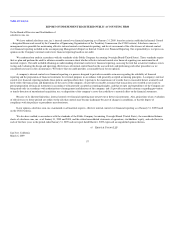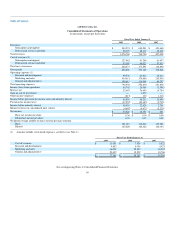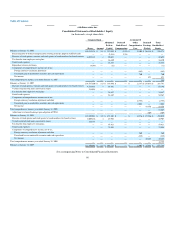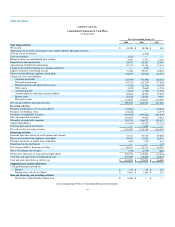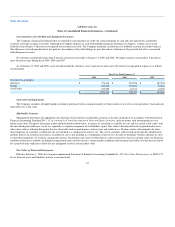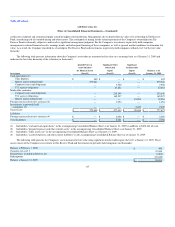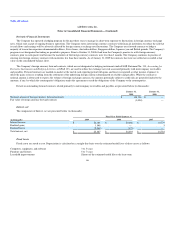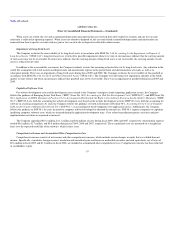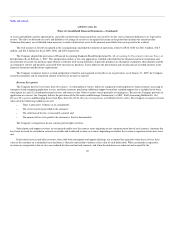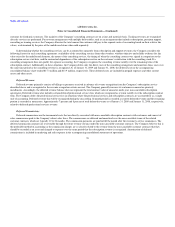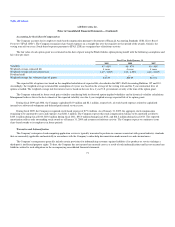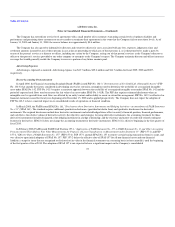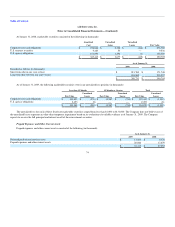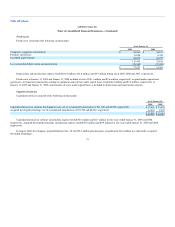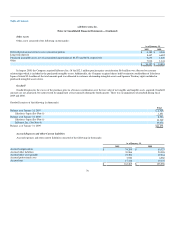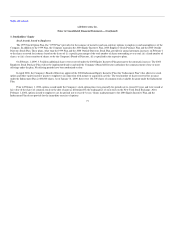Salesforce.com 2008 Annual Report Download - page 70
Download and view the complete annual report
Please find page 70 of the 2008 Salesforce.com annual report below. You can navigate through the pages in the report by either clicking on the pages listed below, or by using the keyword search tool below to find specific information within the annual report.
Table of Contents
salesforce.com, inc.
Notes to Consolidated Financial Statements—(Continued)
When assets are retired, the cost and accumulated depreciation and amortization are removed from their respective accounts and any loss on such
retirement is reflected in operating expenses. When assets are otherwise disposed of, the cost and related accumulated depreciation and amortization are
removed from their respective accounts and any gain or loss on such sale or disposal is reflected in other income.
Impairment of Long-Lived Assets
The Company evaluates the recoverability of its long-lived assets in accordance with SFAS No. 144, Accounting for the Impairment or Disposal of
Long-Lived Assets ("SFAS 144"). Long-lived assets are reviewed for possible impairment whenever events or circumstances indicate that the carrying amount
of such assets may not be recoverable. If such review indicates that the carrying amount of long-lived assets is not recoverable, the carrying amount of such
assets is reduced to fair value.
In addition to the recoverability assessment, the Company routinely reviews the remaining estimated lives of its long-lived assets. Any reduction in the
useful life assumption will result in increased depreciation and amortization expense in the period when such determinations are made, as well as in
subsequent periods. There was no impairment of long-lived assets during fiscal 2009 and 2008. The Company evaluates the recoverability of the goodwill in
accordance with SFAS No. 142, Goodwill and Other Intangible Assets ("SFAS 142"). The Company tests the balance for impairment annually in the fourth
quarter or more often if and when circumstances indicate that goodwill may not be recoverable. There was no impairment of goodwill during fiscal 2009 and
2008.
Capitalized Software Costs
For website development costs and the development costs related to the Company's enterprise cloud computing application service, the Company
follows the guidance of Emerging Issues Task Force ("EITF") Issue No. 00-2, Accounting for Web Site Development Costs ("EITF 00-2"), and EITF Issue No.
00-3, Application of AICPA Statement of Position 97-2 to Arrangements That Include the Right to Use Software Stored on Another Entity's Hardware ("EITF
00-3"). EITF 00-2 sets forth the accounting for website development costs based on the website development activity. EITF 00-3 sets forth the accounting for
software in a hosting arrangement. As such, the Company follows the guidance set forth in Statement of Position 98-1, Accounting for the Cost of Computer
Software Developed or Obtained for Internal Use ("SOP 98-1"), in accounting for the development of its application service. Additionally, the Company
follows the guidance in SOP 98-1 for costs incurred for computer software developed or obtained for internal use. SOP 98-1 requires companies to capitalize
qualifying computer software costs, which are incurred during the application development stage. Costs related to preliminary project activities and post-
implementation activities are expensed as incurred.
The Company capitalized $10.2 million, $11.1 million and $4.8 million of costs during fiscal 2009, 2008 and 2007, respectively. Amortization expense
totaled $6.6 million, $2.7 million, and $0.8 million during fiscal 2009, 2008 and 2007, respectively. These capitalized costs are amortized on a straight line
basis over the expected useful life of the software, which is three years.
Comprehensive Income and Accumulated Other Comprehensive Loss
Comprehensive income consists of net income and other comprehensive income, which includes certain changes in equity that is excluded from net
income. Specifically, cumulative foreign currency translation and unrealized gains and losses on marketable securities and cash equivalents, net of taxes of
$0.6 million in fiscal 2009 and $1.3 million in fiscal 2008, are included in accumulated other comprehensive loss. Comprehensive income has been reflected
in stockholders' equity.
67


